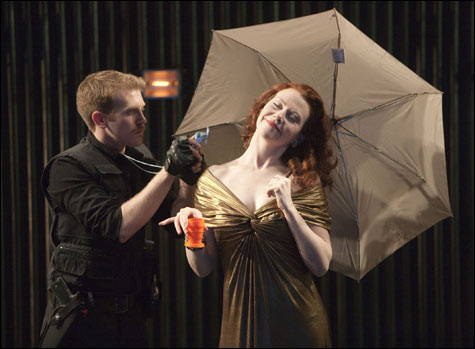
TROJAN BARBIE: In melding ancient and modern, Christine Evans creates some artful parallels and searing images but also some problems. |
From Helen of Troy to Barbie of the plastic hourglass, men and girls have been inspired by impossible ideals of female physical perfection. Helen, of course, will always have Paris, whereas Mattel's muse gets stuck with Trojan Barbie. Christine Evans's self-described "modern car-crash encounter with Euripides's Trojan Women," which is receiving its world premiere courtesy of the American Repertory Theatre (at Zero Arrow Theatre through April 22), does not actually deploy Barbie against the forces of Agamemnon or drag her off to the camp where captive women await transport to Greece and slavery. Barbie (or pieces and parts of her) appears in the play only as a set piece: decorations on a heart-shaped, shard-studded sculpture created by Trojan queen Hecuba's youngest daughter after a museum tour of art objects built from broken stuff. What Evans actually inserts into The Trojan Women is a less-than-stoic Western sensibility and allusions to the Iraq War.
A British doll-repair expert who opts for a "cultural tour for singles" to the site of the former Troy, in what's now Turkey, Lotte Jones is so uptight and organized that she alphabetizes her to-take list ("tickets, traveler's checks, Tic-Tacs"). One moments this timorous cross between Geppetto and Shirley Valentine is sipping lemonade at a tourist boîte; the next, she's tumbling through the looking glass into Euripides's play with a little help from co-dramatist Evans. Confronted by a panicked Andromache cradling a porcelain-doll son and then herded with her new companion into a rubble-strewn camp plopped in a time warp between ancient Troy and a ravaged contemporary desert kingdom being monitored by a multinational force, our cowering heroine is stuck in a war zone where she can't even raise the British Embassy on her cellphone.

It's clear that Trojan Barbie is neither Greek tragedy nor contemporary realism. And in melding ancient and modern, Evans creates some artful parallels and searing images but also some problems. Her writing, especially for the sexually raging Cassandra, can be quite visceral. And though the character of Lotte, even in the capable hands of Karen MacDonald, verges on crumpets-and-affronted-Empire cliché, Evans makes a spunky victim of Hecuba's daughter Polyxena, who does not appear in The Trojan Women but whose sacrifice at the tomb of Achilles is among the queen's related woes. Rechristened Polly X and costumed like a Catholic schoolgirl, the child here spends several tense scenes swilling beer with a sort of good-cop/bad-cop team of rape-minded Western soldiers before meeting her fate — posed like Christ against the backdrop of her own broken-Barbie sculpture. And as personified by ART Institute actor Kaaron Briscoe, she exudes a mix of credulousness and fearlessness that's quite touching.
But Trojan Barbie lacks the interior logic such a vehicular-collision concept requires. Although a repatriated Lotte coos embarrassedly about the media attention incurred by her rescue, a coda featuring a convenient mental patient suggests that, like the final season of Dynasty, her experience among the sorrowing Trojan women may have been a dream. Certainly for Paula Langton's ranting, sobbing Hecuba, it's a bit of a nightmare. The excellent actress, backed by a punk-clad distaff duo of a Greek Chorus, carries on as if she were actually in the play by Euripides, and set amid all the contemporary ironic counterpart she comes off as an overwrought old bore.
As for the play's toys in the Attic, the doll contingent constitutes an effective visual metaphor, with the dead of Troy represented by broken moppets dangled from a rod above the skewed wreckage of David Reynoso's brutalist set and the corpse of Hecuba's murdered grandson, Astyanax, stood in for by a shattered figurine not even Lotte can repair. But what has any of this to do with the half-century-old icon of Mattel? Evans might have made more of the parallels between plastic, empty-headed Barbie and Helen, the latter portrayed by Institute student Careena Melia as a Rita Hayworth type trailing classically inspired gowns and old-movie music. But she doesn't. In fact, Evans's Helen is smart enough to use her feminine wiles to score Perrier and aspirin from the troops and can't understand why her fellow captives do not.
Long-time Súgán Theatre Company honcho Carmel O'Reilly is at the helm of the striking production, which serves as a showcase for a talented Institute posse that also includes Nina Kassa as the luridly prescient Cassandra and Skye Nöel as a pearl-clad Mad Men–era Andromache. But Trojan Barbie remains less a fully thought-out cohesion than something you might find in the playwriting aisle of Ploys "R" Us.